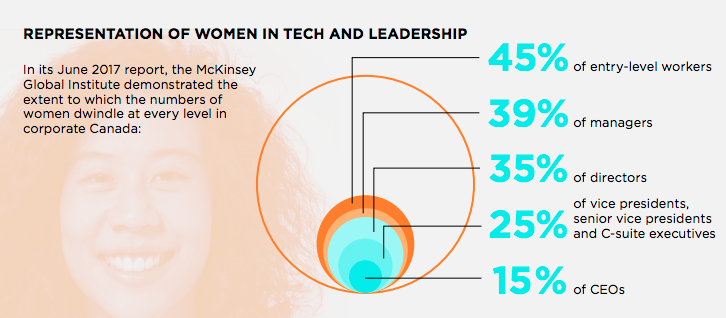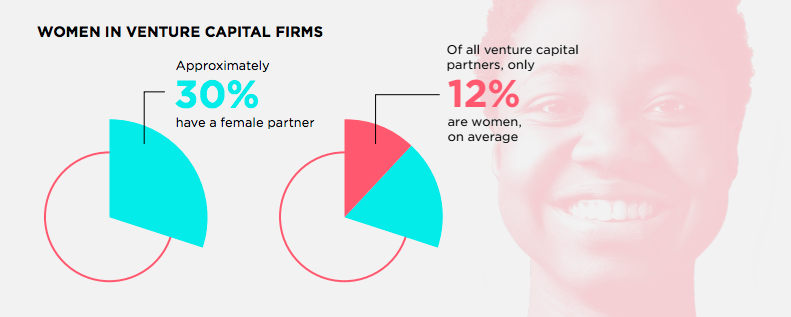The presence of more women in specific positions can lead to an increased presence across company leadership, according to the #MoveTheDial report on the state of women in Canadian tech.
“If you have more women at the top early on, you’ll have more women in your company.”
Co-authored with PwC Canada and MaRS (BetaKit was also a contributing partner), the Where’s the Dial Now? report examines a wide range of gender inequity issues in the tech world, including the number of women CEOs, founders, and VCs; the rate of women graduating in STEM; and some of the barriers that these groups face.
According to the report, women comprise 13 percent of the average tech company’s executive team, while 53 percent of tech companies have no women executives at all. However, it noted that of the companies that do have women executives, women then make up 13 percent of the board. In companies with no female executives, only four percent of board members were women.
“While these numbers leave a lot to be desired, they do show how women can move the dial for other women,” the report reads.
When a company has a woman as a CEO, 48 percent of the executive team is made up of women — compared to only 11 percent when the CEO is a man.

“If there are women on the board, or women in CEO roles, the numbers of women overall are substantially higher,” Colleen Moorehead, chief client officer at Osler, says in the report. “So that really reads to the ‘If I see one I can be one’ mentality. When you are sitting in leadership roles as a woman, you can drive that change.”
“That really reads to the ‘If I see one I can be one’ mentality. When you are sitting in leadership roles as a woman, you can drive that change.”
– Colleen Moorehead, Osler
While the report is optimistic about an increase in women founders — 28 to 30 percent of ventures surveyed by MaRS had at least one woman on the founding team — there is still work to be done. In BDC’s portfolio, on average only 13 percent of CEOs are women, 15.8 percent of C-suite positions are held by women, and 14.3 percent of founders or co-founders are women. It suggests that part of the struggle comes from a lack of mentorship opportunities and peer-to-peer networks, so fostering a community where leaders show up to support founders can help. It’s worth noting that BDC also recently injected an additional $20 million in its fund dedicated to investing in women-led companies.
To build the next generation of women founders, the report recommends that women take the leap into entrepreneurship as a way to move the dial. “I believe we need to have more startups that are scaling and that are training people to work in the technology industry,” said Michelle McBane, investor at MaRS IaF. “Furthermore, if you have more women at the top early on, you’ll have more women in your company, because these are high-growth ventures that will hire from diverse talent pools from the onset.”
Bringing more women onto boards was also identified as one of the best ways to bring more diversity into a tech company more broadly, because they determine the direction of the company. On average, only eight percent of directors in Canadian companies are women, while 73 percent of tech companies have no women on the board at all.

In cases where there are women on the board of directors, about 22 percent of the executive team consists of women, compared to 10 percent when women are excluded from the board. Of companies with women on the board of directors, 16 percent have a woman founder, and 14 percent have a woman as CEO.
When a company’s board is constituted of men only, four percent of companies had a woman founder and two percent have a woman as CEO.
#MoveTheDial said that the three things needed to get women on boards include an actual desire to bring more women onto boards, a strong supply of women (though lists like theBoardlist indicate supply is not a major issue), and awareness among decision-makers on where to find more women talent.

“We need to put our money where our mouth is: less talk, more action,” said Jessica Yamoah, co-founder of Innovate Inclusion. “Government and corporations can start by holding themselves accountable, and acknowledging the value of what diverse groups bring to the table. Companies need to work with internal and external stakeholders who embody and intrinsically understand diversity. Rather than lip service, we need to commit financial and human resources that can be evaluated over time. Invest in systemic changes, not bandaid, stand-alone initiatives that put organizations with similar interests in competition for limited resources and funding.”
Even when women are interested in pursuing work in tech companies, employee attrition is an issue in STEM fields as women don’t feel that they belong in organizations dominated by men. Internal mentorship or skill development programs, funding internal initiatives, or promoting community organizations that nurture talent can be steps to tackle this problem.
Review the full report here.
Photo via Unsplash


